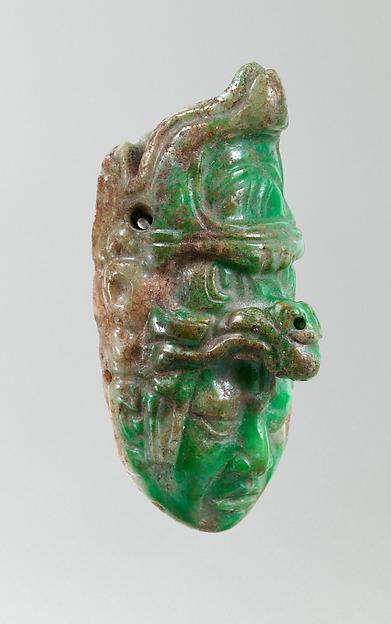
Object Title
Pendant
Measurements
H. 3 × W. 1 1/2 × D. 1 1/2 in. (7.6 × 3.8 × 3.8 cm)
Creation Date
A.D. 600–700
Credit Line
Gift of Steven Kossak, The Kronos Collections, 2015
Museum Name
Culture
Country of Origin
Object Type
Materials / Techniques
Object URL
http://www.metmuseum.org/art/collection/search/701645?sortBy=Relevance&ft=kossak+pendant&offset=0&rpp=20&pos=1
Provenance Information
Reportedly Collection of Jorge Castillo (d. 1977), Guatemala City; Reportedly Collection of David Bramhall, New York; [Judith Small Nash, Woodstock, NY, until 1990]; Steven Kossak, The Kronos Collections, New York, until 2015; Gift of Steven Kossak to The Metropolitan Museum of Art in 2015.
Exhibition Information
None
Publication Information
None
Section of the AAMD Guidelines relied upon for the exception to 1970
Informed judgement that works were outside of the country of modern discovery before 1970
Explain why the object fits the exception set forth above
The work was reportedly in the collection of Jorge Castillo, a well-known collector of Maya art in Guatemala City who was active from the 1960s until his death in 1977. He left the majority of his collection to the Universidad Francisco Marroquín, Guatemala City, where it was catalogued between 1975 and 1978 in preparation for the formation of a museum, now known as the Museo Popol Vuh. This work was not catalogued and added to the collection of the Museo Popol Vuh, and it is possible it was sold by Castillo before he had made plans for the formation of the museum.
Judith Small Nash sold the work in 1990 to the current owner. Ms. Nash may have acquired the work from David Bramhall (and recalls that he may have acquired it from the Castillo family). Mr. Bramhall was an active dealer in the 1960s and 1970s and reportedly had a long-term relationship with the Castillo family going back to the 1950s. The Judith Small Nash Gallery was one of the leading vendors of Precolumbian and Native American from the 1960s until the owner’s retirement in the 2000s.
Among the corpus of Maya crown jewels, this work is among the top five ever found, and the only one not currently in a public collection. The work is exceptional for its relative size, the beauty of the apple-green jade (the shade most preferred by the Maya), and the outstanding sculptural qualities of the work. The richly volumetric carving sets this work apart from known, flatter compositions. This gift enhances the Metropolitan Museum’s ability to convey the splendor of Mayan royal regalia to visitors.
Judith Small Nash sold the work in 1990 to the current owner. Ms. Nash may have acquired the work from David Bramhall (and recalls that he may have acquired it from the Castillo family). Mr. Bramhall was an active dealer in the 1960s and 1970s and reportedly had a long-term relationship with the Castillo family going back to the 1950s. The Judith Small Nash Gallery was one of the leading vendors of Precolumbian and Native American from the 1960s until the owner’s retirement in the 2000s.
Among the corpus of Maya crown jewels, this work is among the top five ever found, and the only one not currently in a public collection. The work is exceptional for its relative size, the beauty of the apple-green jade (the shade most preferred by the Maya), and the outstanding sculptural qualities of the work. The richly volumetric carving sets this work apart from known, flatter compositions. This gift enhances the Metropolitan Museum’s ability to convey the splendor of Mayan royal regalia to visitors.